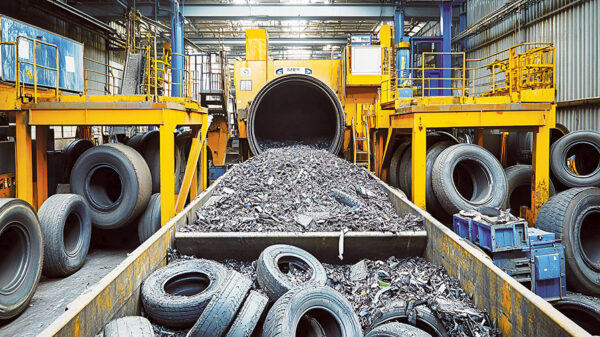The U.S. Environmental Protection Agency (EPA) announced final national greenhouse gas pollution standards for heavy-duty vehicles, such as freight trucks and buses, for model years 2027 through 2032. The standards will avoid one billion tons of greenhouse gas emissions and provide $13 billion in annualized net benefits to society related to public health, the climate, and savings for truck owners and operators. The final standards will also reduce air pollution.
The “Greenhouse Gas Emissions Standards for Heavy-Duty Vehicles – Phase 3” standards will provide greater certainty for industry, while catalyzing private investment, supporting U.S. manufacturing jobs in advanced vehicle technologies, and invigorating and strengthening the U.S. economy.
Trucks and other heavy-duty vehicles are vital to the U.S. economy, transporting goods and freight and providing services for industry, transit, and other sectors. At the same time, heavy-duty vehicles account for 25 percent of all greenhouse gas emissions from the transportation sector, which is itself the single largest source of greenhouse gas emissions in the U.S.
“Phase 3” standards build on EPA’s Heavy-Duty Phase 2 program from 2016 and maintain that program’s flexible structure, which is designed to reflect the diverse nature of the heavy-duty vehicle industry. The standards are technology-neutral and performance-based, allowing each manufacturer to choose what set of emissions control technologies is best suited for them and the needs of their customers. Available technologies include advanced internal combustion engine vehicles, hybrid vehicles, plug-in hybrid electric vehicles, battery electric vehicles, and hydrogen fuel cell vehicles. These new standards apply to heavy-duty vocational vehicles (such as delivery trucks, refuse haulers, public utility trucks, and transit, shuttle, and school buses) and tractors (such as day cabs and sleeper cabs on tractor-trailer trucks).
Relative to the proposal, EPA’s final rule provides more time in the early model years of the program for the development of vehicle technologies and deployment of charging and refueling infrastructure. The final rule also includes flexibilities that will assist manufacturers in meeting the standards in the early years of the program while preserving incentives for early adoption of advanced technologies.
EPA received extensive feedback on the proposed rule, including over 175,000 public comments, testimony at public hearings, and engagement with stakeholder groups. The final standards were informed by the best available data and information in the public record and rigorous technical assessments, including consideration of the extensive public input EPA received in response to the proposed rulemaking.
There is a wide variety of trucks and other heavy-duty vehicles on the road, serving a diverse array of needs and customers. These standards recognize the diversity of vehicle types and encourage further innovations in clean vehicle technology, enhancing options at the dealership that will also save customers, owners, and operators money through reduced fuel and maintenance costs. Under these new standards, the heavy-duty industry is expected to realize annualized savings of $3.5 billion compared to annualized costs of about $1.1 billion from 2027 through 2055.
After accounting for the vehicle purchase tax credits provided under the Inflation Reduction Act, the typical buyer of new clean technology vocational vehicles and day cabs in 2032 when the standards are fully phased in will save money on the upfront cost of the vehicles and recoup any additional costs, such as the purchase and installation of vehicle charging equipment, in two to four years. The typical buyer of new clean technology sleeper cab will recoup the upfront cost of a vehicle in five years. A purchaser of a heavy-duty truck in 2032 – when the standards are fully phased in – could save between $3,700 and $10,500 on fuel and maintenance costs annually, depending on vehicle type.
Working with Stakeholders Throughout Phase 3 Implementation
EPA’s analysis finds that heavy-duty vehicle technologies, charging and refueling infrastructure, and supply chains will be available to support the final standards. At the same time, EPA has committed to actively monitor and track the technologies the heavy-duty vehicle manufacturers are developing and deploying, and the deployment of heavy-duty vehicle electric charging and hydrogen fueling infrastructure in order to ensure the successful implementation of the Phase 3 program.
EPA will consult with a wide range of stakeholders on an ongoing basis to learn from their experiences and gather relevant information and data. These stakeholders will include, at a minimum, trucking fleets and trucking trade associations; heavy-duty vehicle owner-operators; heavy-duty vehicle manufacturers; investor-owned utilities, public utilities, and electricity cooperatives; infrastructure providers and installers; state and local governments, communities with environmental justice concerns; and environmental and public health NGOs. In consultation with other agencies, beginning as early as 2026, EPA will issue periodic reports reflecting the collected information throughout the lead-up to and during the implementation of the Phase 3 standards. Based on these reports, the agency may decide to issue guidance documents, initiate a future rulemaking to consider modifications to the Phase 3 rule, or make no changes to the program.
In parallel to the Phase 3 rule, the Joint Office of Energy and Transportation and the Department of Energy, in collaboration with the Department of Transportation and the Environmental Protection Agency, recently announced the first-ever National Zero Emission Freight Corridor Strategy, an all-of-government action plan for deploying a world-class zero-emission freight network across the nation by 2040. The Strategy prioritizes high-traffic routes and freight hubs to catalyze four phases of public and private investment in heavy-duty zero-emission transportation, with a focus on reducing harmful emissions for the most affected communities.
Investing in America’s Clean Transportation Future
The final standards align with and support the commitments and billions of dollars’ worth of investments from trucking fleets, vehicle manufacturers, and vehicle technology firms as they plan to increase the use or production of clean vehicle technologies in trucking and other heavy-duty fleets. These investments are resulting in a range of technologies with the potential for further significant reductions of greenhouse gas emissions from heavy-duty motor vehicles.
For more information on the Phase 3 Final Rulemaking, visit EPA’s Final Rule: Greenhouse Gas Emissions Standards for Heavy-Duty Vehicles – Phase 3 website.






